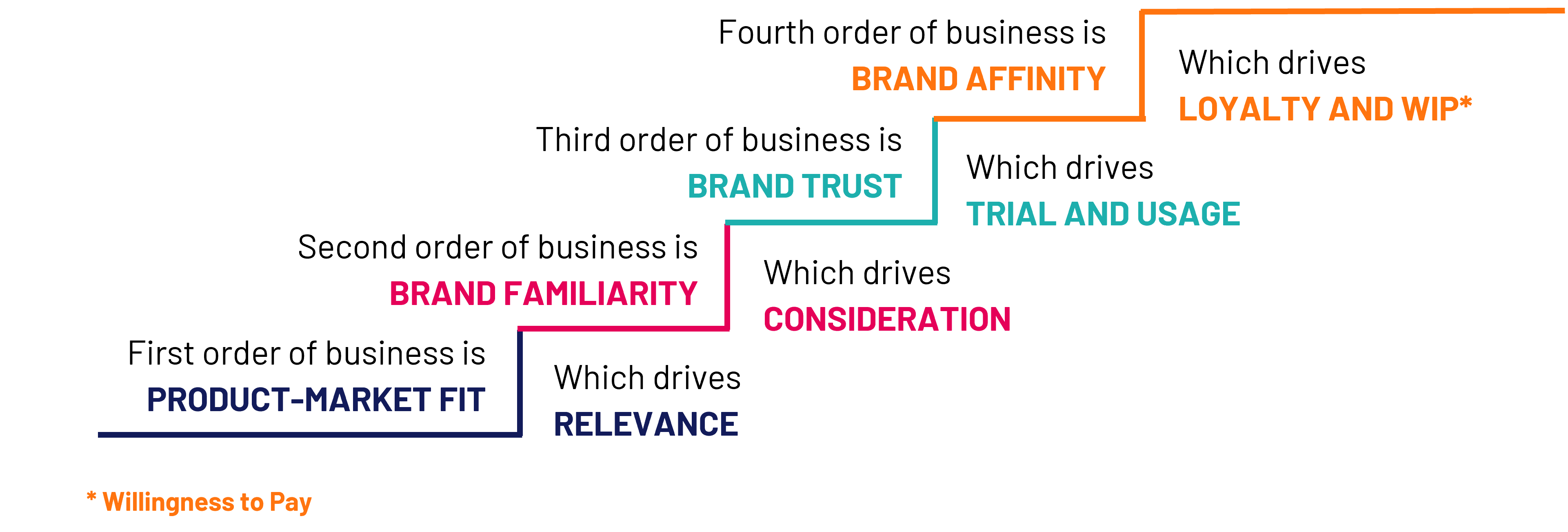The Brand Strength Ladder
Analysing 70+ Norwegian and international brands in our BrandCheck benchmark database, we have identified four crucial dimensions that characterises the strongest and most valuable brands. These dimensions are interrelated and form the steps of a ladder that brand builders must climb to reach real and sustained brand success.
The Brand Strength Ladder

- The first order of business is to have high product-market fit. The product or service you offer needs to align with the needs of your customers. This is the first and fundamental step on the brand strength ladder. If you have product-market fit, you have the required relevance to compete. However, if your product doesn’t align with what the category buyers expects, you will never get it off the ground. You can’t salvage a poor product with a great brand, at least not in the long run.
- The second order of business is to build brand familiarity. Familiarity goes beyond mere brand awareness, as on average only 45 % of those who are aware of a brand report that they are highly familiar with it. This is marketing territory, where strong brand assets and repetition of a consistent message over time is crucial. Brand familiarity is typically what pushes people from merely being aware of its existence, to actively considering the products or services offered.
- The third order of business it to build brand trust. This is basically about not screwing up, about consistently over time delivering what you promise, about being transparent and ethical. If you can get other people to recommend your brand, great! Brand trust is typically what drives trial and repeat usage. In our analysis high trust brands have on average 169 % higher market penetration than low trust brands.
The fourth order of business is to build brand affinity. Consumers that have an emotional connection to the brand is much more likely to actively prefer it over any other brand and are even willing to pay a premium for its products and services. This goes beyond just satisfying the customers, but creating a customer experience that truly makes them join your team.
An important point to be made is that you can only build a brand through climbing the brand strength ladder from the bottom up. There is no point having high brand affinity, if brand trust is lacking. Trying to build trust without familiarity is an impossible task. No amount of brand familiarity will sell your product, if they don’t align with what people are looking for.
Only 14% of the brands in our benchmark database have climbed all the way to the top of the Brand Strength Ladder. The blood, sweat and tears are worth it, as the view from the top is spectacular. Compared to other brands, the brands at the top of the ladder enjoys 2.9 times higher usage, 2.7 times higher brand loyalty and 2.3 times higher willingness to pay.
This clearly shows that if you manage to combine strong product-market fit with high brand familiarity, brand trust and brand affinity, you are all set for profitable, sustained growth.
BrandCheck is Ipsos Norway’s innovative platform for branding insights. Combining laser-focused, non-nonsense questionnaire modules, automated platforms for conducting fieldwork and AI-tools to enhance analysis, we can offer brand strategy insights at speed and to a fraction of the cost of traditional market research.
To date we have a reference index of 70+ Norwegian and global brands, across multiple industries, that has been part of the meta-analysis. The analysis looks at drivers of crucial brand strength metrics across all brands. Patterns and relationships in the sample of brands are consistent and robust but cannot necessarily be generalized outside of the sample of brands included.




